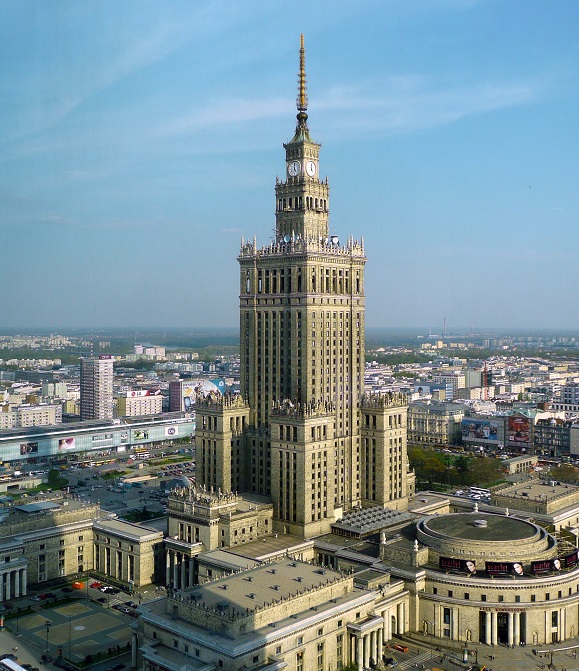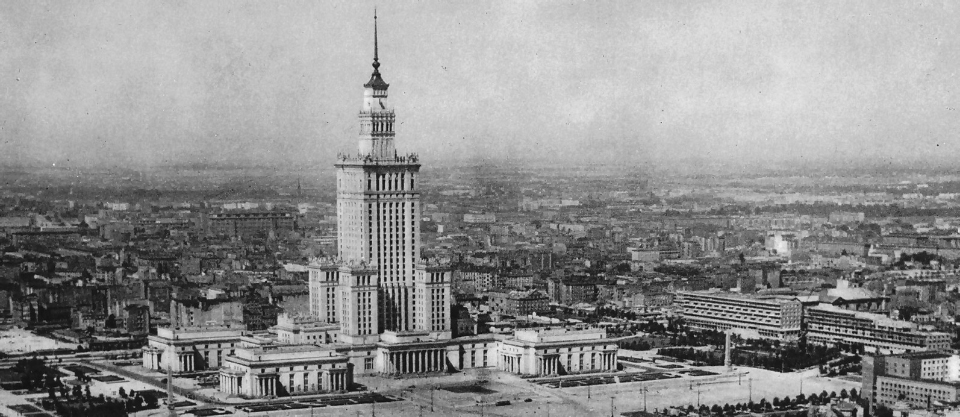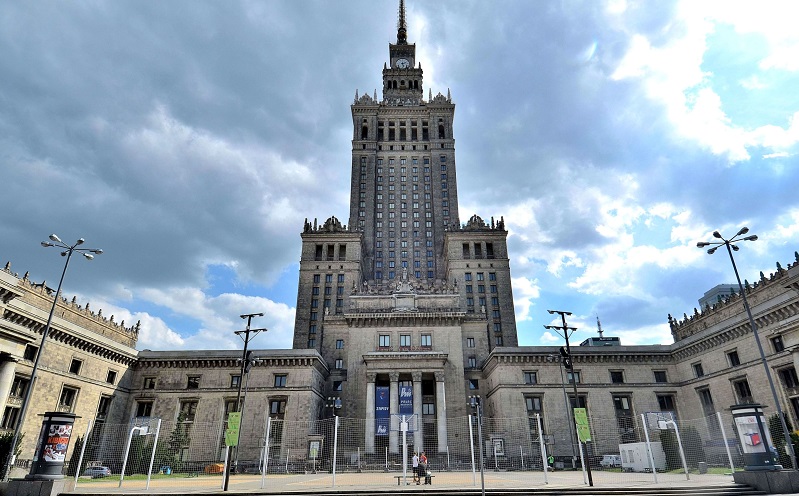Palace of Culture and Science
Contents |
[edit] Introduction
The Palace of Culture and Science (PKiN), is a modernist high-rise building in Warsaw, Poland. At 237 m (778 ft) tall, including a 43 m-high spire, it is the tallest building in Poland, and one of the most visible and recognisable landmarks in Warsaw.
Completed in 1955, PKiN has long provoked controversy as it was intended as a ‘gift’ from the Soviet Union to Poland, but many considered it to be a symbol of Soviet domination; indeed its original name was the Joseph Stalin Palace of Culture and Science.
The negativity felt by Poles towards the building was also due to the design following that of the ‘Seven Sisters’ high-rises in Moscow, leading to many seeing the PKiN as an ‘oppressive outpost’ of the USSR in the centre of Warsaw. Indeed, it is often referred to as the ‘Eighth Sister’. Stalin’s name was removed from the building in the wake of the ‘De-Stalinisation’ process that took place after the leader’s death through to Polish independence in the early-1990s.
Today, the PKiN has gained more acceptance among Poles, particularly younger generations. The urbanist writer Owen Hatherley praised the building, describing it as architecturally superior to the ‘Seven Sisters’ upon which it was modelled.
[edit] Design and construction
The main architect for the building was Lev Rudnev, who followed the architecture of the ‘Seven Sisters’ high-rises in Moscow, which are often likened to shorter and more squat versions of the American art deco skyscrapers such as the Empire State Building. Rudnev attempted to create an eclectic mix of a steel-framed structure with Russian baroque and gothic details.
However, Rudnev also visited several Polish heritage sites in Krakow and Zamosc to study the Polish Renaissance architecture of the houses and palaces there. As a result, he decorated the roof with spiky masonry ‘Polish parapets’. Regardless of this, many critics at the time and since completion, argued that the monumental scale of the building was at odds with the aesthetic balance of the old city of Warsaw and that it imposed dissonance with its surroundings.
The elaborate exterior is surrounded by monumental classical sculptures of Copernicus, Adam Mickiewicz, Marie Curie, and others. The interior is also very elaborate, with marble floors, vast staircases, gilded finishes and large glass chandeliers.
Construction began in 1952, when most of the surrounding area, and indeed the rest of the city, still lay in ruins after the Second World War. It was built by 3,500-5,000 Russian and 4,000 Polish workers.
[edit] Post-completion
As Poland asserted itself post-Soviet Bloc status, and since gaining membership of the European Union, attitudes towards the PKiN have begun to soften, particularly in the wake of more high-tech, modernist skyscrapers completed in the last few years.
The building serves as headquarters of a number of private companies and public institutions. It hosts concerts, museum exhibitions, a popular cinema, bars and even Poland’s largest casino. The 30th floor terrace provides a panoramic view of the city and is a popular tourist attraction.
In 1999 four clock faces measuring 6.3 m in height were added to the top of the building in time for the celebrations of Millennium Eve.
In 2010, high-power LED lights were installed as a means of modernising the lighting of the buildings and allowing a range of colours to be displayed at night and for special occasions.
[edit] Related articles on Designing Buildings Wiki
- Building of the week series.
- Empire State Building.
- Imagine Moscow exhibition.
- Ministry of Transportation Building, Georgia.
- Nowa Huta - Communist tour review.
- Owen Hatherley - Landscapes of Communism.
- Socialist realism in a post-war Czechoslovak new town.
- The Kremlin.
- Upside Down House, Poland.
- Zlota 44, Warsaw.
Featured articles and news
RTPI leader to become new CIOB Chief Executive Officer
Dr Victoria Hills MRTPI, FICE to take over after Caroline Gumble’s departure.
Social and affordable housing, a long term plan for delivery
The “Delivering a Decade of Renewal for Social and Affordable Housing” strategy sets out future path.
A change to adoptive architecture
Effects of global weather warming on architectural detailing, material choice and human interaction.
The proposed publicly owned and backed subsidiary of Homes England, to facilitate new homes.
How big is the problem and what can we do to mitigate the effects?
Overheating guidance and tools for building designers
A number of cool guides to help with the heat.
The UK's Modern Industrial Strategy: A 10 year plan
Previous consultation criticism, current key elements and general support with some persisting reservations.
Building Safety Regulator reforms
New roles, new staff and a new fast track service pave the way for a single construction regulator.
Architectural Technologist CPDs and Communications
CIAT CPD… and how you can do it!
Cooling centres and cool spaces
Managing extreme heat in cities by directing the public to places for heat stress relief and water sources.
Winter gardens: A brief history and warm variations
Extending the season with glass in different forms and terms.
Restoring Great Yarmouth's Winter Gardens
Transforming one of the least sustainable constructions imaginable.
Construction Skills Mission Board launch sector drive
Newly formed government and industry collaboration set strategy for recruiting an additional 100,000 construction workers a year.
New Architects Code comes into effect in September 2025
ARB Architects Code of Conduct and Practice available with ongoing consultation regarding guidance.
Welsh Skills Body (Medr) launches ambitious plan
The new skills body brings together funding and regulation of tertiary education and research for the devolved nation.
Paul Gandy FCIOB announced as next CIOB President
Former Tilbury Douglas CEO takes helm.
UK Infrastructure: A 10 Year Strategy. In brief with reactions
With the National Infrastructure and Service Transformation Authority (NISTA).

























